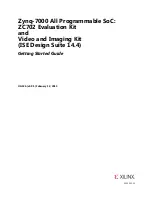
USB on-the-go full-speed (OTG_FS)
RM0090
1242/1731
DocID018909 Rev 11
Endpoint status/interrupt
The device endpoint-
x
interrupt registers (DIEPINT
x
/DOPEPINT
x)
indicate the status of an
endpoint with respect to USB- and AHB-related events. The application must read these
registers when the OUT endpoint interrupt bit or the IN endpoint interrupt bit in the core
interrupt register (OEPINT bit in OTG_FS_GINTSTS or IEPINT bit in OTG_FS_GINTSTS,
respectively) is set. Before the application can read these registers, it must first read the
device all endpoints interrupt (OTG_FS_DAINT) register to get the exact endpoint number
for the device endpoint-
x
interrupt register. The application must clear the appropriate bit in
this register to clear the corresponding bits in the DAINT and GINTSTS registers
The peripheral core provides the following status checks and interrupt generation:
•
Transfer completed interrupt, indicating that data transfer was completed on both the
application (AHB) and USB sides
•
Setup stage has been done (control-out only)
•
Associated transmit FIFO is half or completely empty (in endpoints)
•
NAK acknowledge has been transmitted to the host (isochronous-in only)
•
IN token received when Tx-FIFO was empty (bulk-in/interrupt-in only)
•
Out token received when endpoint was not yet enabled
•
Babble error condition has been detected
•
Endpoint disable by application is effective
•
Endpoint NAK by application is effective (isochronous-in only)
•
More than 3 back-to-back setup packets were received (control-out only)
•
Timeout condition detected (control-in only)
•
Isochronous out packet has been dropped, without generating an interrupt
34.6 USB
host
This section gives the functional description of the OTG_FS in the USB host mode. The
OTG_FS works as a USB host in the following circumstances:
•
OTG A-host
–
OTG A-device default state when the A-side of the USB cable is plugged in
•
OTG B-host
–
OTG B-device after HNP switching to the host role
•
A-device
–
If the ID line is present, functional and connected to the A-side of the USB cable,
and the HNP-capable bit is cleared in the Global USB Configuration register
(HNPCAP bit in OTG_FS_GUSBCFG). Integrated pull-down resistors are
automatically set on the DP/DM lines.
•
Host only (see figure
Figure 389: USB host-only connection
).
–
The force host mode bit in the global USB configuration register (FHMOD bit in
OTG_FS_GUSBCFG) forces the OTG_FS core to work as a USB host-only. In this
case, the ID line is ignored even if present on the USB connector. Integrated pull-
down resistors are automatically set on the DP/DM lines.
Note:
On-chip 5 V V
BUS
generation is not supported. For this reason, a charge pump or, if 5 V are
available on the application board, a basic power switch must be added externally to drive
















































